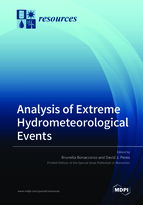Analysis of Extreme Hydrometeorological Events
A special issue of Resources (ISSN 2079-9276).
Deadline for manuscript submissions: closed (31 December 2021) | Viewed by 24388
Special Issue Editors
Interests: hydrology; drough; extreme rainfall; statistics methods
Interests: hydrology; landslides; early warning systems; risk awareness; prediction performance and uncertainty; climate change; hazard and susceptibility mapping
Special Issue Information
Extreme hydrometeorological events (e.g., storms, pluvial, fluvial and coastal floods, droughts, and landslides), causing severe impacts in terms of injuries, casualties, and socio-economic losses, are being reported more and more frequently all over the world. It is common for these events to have cascading effects that can span from slope instability to ecological disasters, involving infrastructural and service disruptions.
Climate variability and anthropogenic changes (e.g., population increase, urbanization, and environmental degradation) play an important role in amplifying the impacts of these events on a growing number of people. Therefore, understanding the dynamics inherent to these phenomena, improving early warning systems, and developing more coordinated disaster risk reduction strategies are fundamental to properly managing the associated risk, reducing vulnerabilities, and building the societal resilience to natural disasters.
The aim of this Special Issue is to showcase studies addressing challenges in monitoring, modeling, forecasting, and assessing the impacts of hydrometeorological hazards. We welcome both research papers and technical notes on the analysis of hydrometeorological extreme events at local, catchment, and global scales.
Studies may focus on: (i) the description of recent relevant extreme hydrometeorological events, accompanied by analyses of spatio-temporal features and trends; (ii) the estimation and projection of the impacts of climate change and land-use transformations on the occurrence and severity of hydrometeorological extreme events, with associated uncertainties; (iii) the integration of remote sensing data or climate forecasts and models to provide timely warnings or reliable predictions; (iv) the use of advanced statistical methodologies to characterize extreme hydrometeorological events, among others.
Dr. Brunella Bonaccorso
Dr. David J. Peres
Guest Editors
Manuscript Submission Information
Manuscripts should be submitted online at www.mdpi.com by registering and logging in to this website. Once you are registered, click here to go to the submission form. Manuscripts can be submitted until the deadline. All submissions that pass pre-check are peer-reviewed. Accepted papers will be published continuously in the journal (as soon as accepted) and will be listed together on the special issue website. Research articles, review articles as well as short communications are invited. For planned papers, a title and short abstract (about 100 words) can be sent to the Editorial Office for announcement on this website.
Submitted manuscripts should not have been published previously, nor be under consideration for publication elsewhere (except conference proceedings papers). All manuscripts are thoroughly refereed through a single-blind peer-review process. A guide for authors and other relevant information for submission of manuscripts is available on the Instructions for Authors page. Resources is an international peer-reviewed open access monthly journal published by MDPI.
Please visit the Instructions for Authors page before submitting a manuscript. The Article Processing Charge (APC) for publication in this open access journal is 1600 CHF (Swiss Francs). Submitted papers should be well formatted and use good English. Authors may use MDPI's English editing service prior to publication or during author revisions.
Keywords
- hydrometeorological hazards
- monitoring and early warning
- modelling
- forecasting
- risk analysis
- cascading effects







